
The urban century
We are living in the “urban century” taken that urbanization leads to more and more people to live in cities. As a matter of fact, according to the projections of the European Environment Agency (2017) by the year 2030, 75% (on the average) of Europeans will live in cities. As a result of urbanization, a number of environmental, social and economic problems have developed, directly affecting the quality of life of people and resulting in social disparities.
Sustainable development and urban regeneration constitute two main targets of the urban policy of the European Union. Their successful implementation is supportive for a viable environmental, climate friendly, economic and social future for the urban population.
Before cities commit to significant policy initiatives, there is a need to improve their understanding on “Science in the City”:
how urban microclimate is controlled, especially for cities exposed to overheating, what is the impact of urban form (e.g. buildings) and functions (e.g. transport, industry) to local environmental conditions, how extreme events due to climate change (e.g. heat waves or flash rains) impact the city, etc.
In practical terms, cities need to plan urban solutions by taking note of scientific knowledge on the interactions between the built and the open environment, the radiation budget, the contribution of construction materials and greenery to the city’s thermal state, the ventilation (airflow) patterns at local scale, etc.
Three ideas to consider
The 1st idea is that climate responsive urban design is vital to urban sustainability: it enables the reduction of air and ground surface temperatures in individual buildings and their surroundings, it enhances thermal comfort and activity in outdoor spaces, and it may encourage city dwellers to moderate their dependence upon air conditioning in buildings and private vehicles.
The 2nd idea is that “One solution does not fit all”, in other words a solution which may be successful in one part of the city, may be proven inadequate at another. Similarly a solution which may improve the thermal performance of a building in one neighborhood, may be proven of limited merit for another building, even at the same neighborhood.
The 3rd idea is that urban design needs to be participatory, that is to involve citizens, even if their scientific or technical capacities are not to the level needed. Through their participation, urban design becomes a collective endeavor, thus supporting “bottom up” decision making and enhancing social responsibility.
Barcelona at the frontline
Barcelona has integrated the ideas above into an innovative pilot project aiming to develop a network of eleven Climate Shelters around the city. The project has a duration of 3 years and is funded by the Urban Innovation Actions (UIA) of the European Commission.
Eleven pilot schools (the buildings and the open yards) will be transformed into Climate Shelters by hosting blue, green and grey technical measures, in support to the adaptation of the city to climate change. At the same time, the exposure of the school population to urban heat is ameliorated, whereas the possibility for the continuous use of the climate shelters by the wider public in non-school periods and throughout the year is provided.
Image of the school yard, Escola Vila Olimpica) - Image by C. Cartalis
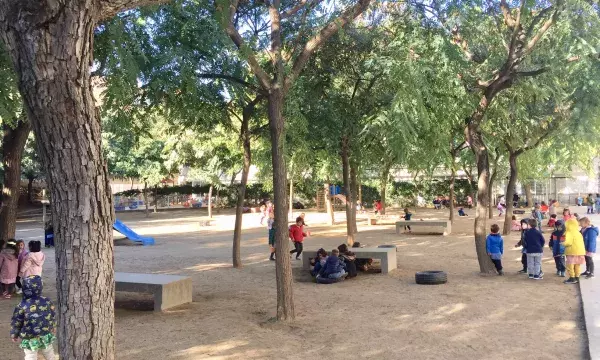
It is important to note that the project foresees upscaling to more schools, a prospect of great importance for the city’s efforts to adapt to climate change and take care of the well-being of the city residents in terms of heat risk prevention.
Science driven guidelines to reach the optimum solutions for the conversion of schools to Climate Shelters
Schools (including their school yards) are excellent examples of public buildings to be converted to Climate Shelters. They are well placed within the neighborhoods of a city thus supporting its adaptation to climate change, whereas their yards can be used for the general public once an extreme event, such as a heat wave, takes place. In addition, they provide once converted, better environmental conditions for students, teachers and parents and they also act as agents of community well-being.
It should be noted that the guidelines to convert a school to Climate Shelter may differ depending on urban form and morphology, the building characteristics and type of materials, the exposure to solar radiation and wind conditions, the percentage of greenery within each school, etc. The guidelines also depend on the prevailing climatic and meteorological conditions. Yet, a set of standardized guidelines may be as follows:
1. How does the balance between the paved and green spaces affect the thermal environment?
Lack of sufficient greenery – as a common characteristic of schools in dense urban areas – in favor of paved surfaces, contributes to the accumulation of heat in the built environment. n addition, the type, the distribution and intensity of urban greenery also affect local wind patterns.
2. Can the building’s volume and orientation be used as a policy guideline to achieve desirable microclimatic conditions in the school?
Buildings’ volume and orientation affect the exposure of urban surfaces to the solar radiation, thus controlling the temperature field as well as the thermal comfort of students and teachers. Thus, urban structure affects shadow patterns and heat exchange in the built environment.
3. Can changes in the urban surface materials’ improve the state of the school’s thermal environment?
Urban surface materials’ thermal characteristics, color, texture and coverage influence heat absorption. Construction materials (cement, asphalt) absorb more solar radiation, thus increasing ground surface temperature as well as the air temperature of the air mass above. Distribution and ratio of land cover classes including paved, vegetated and bare land and surface water contribute to the heat exchange between the urban area and the adjacent air.
4. How ventilation and airflow influence urban solutions?
Green and blue interventions as well as land cover differences develop temperature differences which in turn mix the hotter and cooler air and reduce the intensity of the Urban Heat Island.
5. What are the real effects of vegetation in various urban contexts?
Cooling by evapotranspiration varies by climate, physical and geometrical properties and season but is typically up to 2–3 °C, sometimes higher. Urban vegetation has been observed to cool air up to 3.3 °C.
What about the real world?
The science driven guidelines are exemplified for the Els Llorels school which is one of the 11 schools in the City of Barcelona to be converted to Climate Shelters (Images 1-6 stem from a study realized by Societat Organica for the Barcelona Energy Agency).
What is the building’s volume and orientation at the local urban scale?
The school seems “trapped” between dense building blocks and a street which accommodates traffic in and through the neighborhood. The ventilation potential is limited and the exposure to the sun, results in facades of the school to be more exposed to solar radiation as compared to others (Image 1).
Image 1. The Els Llorels school (bottom left) and its position in the local urban environment (top left and right; from Google Earth).
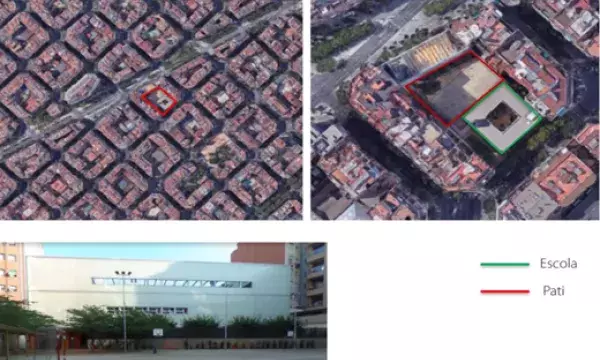
What is the balance between the paved and green spaces within each Climate Shelter?
The school yard is mostly covered by impermeable material. Green is limited (20% of the school yard), practically exhausted at one side of the school yard (Images 2 and 3).
Image 2. The Els Llorers school from a different view (from Google Earth) and a view of the green part of its yard.
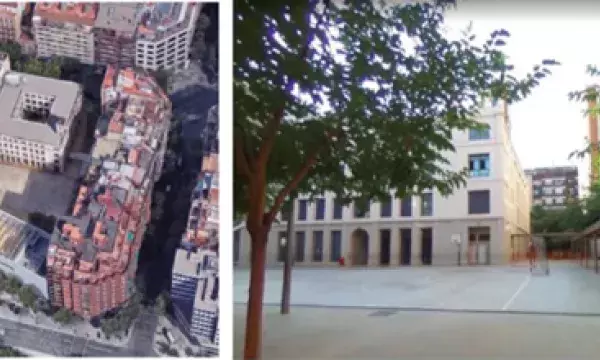
Image 3. Plan view of the school’s yard and its greenery.
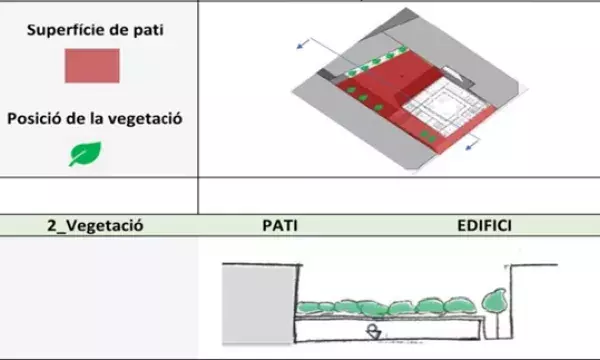
Can the building’s volume and orientation be used as a policy guideline to achieve desirable microclimatic conditions in the school?
The orientation of the school to the sun is provided in Image 4. It is used to estimate the amount of Watt hours (Wh) per m2 at the school yard as well as the side walls of the school at different orientations to the horizon. Yellow and red colors show excessive exposure to solar radiation, a fact leading to the overheating of the building and the school yards, also resulting in thermal discomfort of the students (Image 5).
Image 5. Amount of Watt hours (Wh) per m2 at the school yard as well as the side walls of the school at different orientations to the horizon.
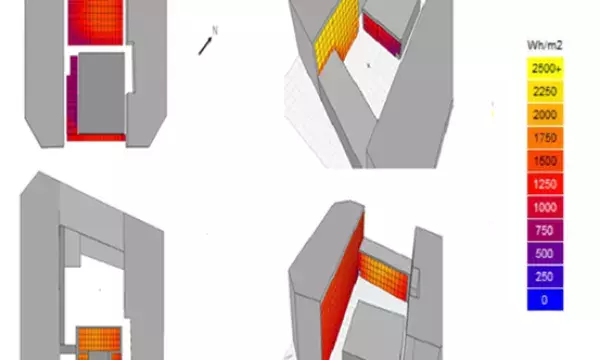
How ventilation and airflow influence the solutions?
Simulations led to the recognition of the school façade being susceptible to higher wind pressure as well as the one more exposed to solar radiation (Image 6).
Image 6. Depiction of the school areas exposed to wind and solar radiation.

Bringing science to the local community
While schools provide a particularly effective starting point to teach students about cause and effect relationships, putting knowledge into actions requires the engagement of the communities at large including parents, families, neighborhoods, universities, local authorities, businesses, etc.
In the Climate Shelters Project, parents, teachers and students first provided their views on the measures to be applied at each school so as to be converted to a Climate Shelter.
In the case of the Els Llorels school, a total of 258 people participated in the survey with their answers categorized in three groups “students” (153), “parents” (90) and “teachers” (15) (Source: Barcelona City Council – Urban Ecology Area).
Answers varied in terms of the priorities recognized per group; for example and as seen in Figure 1, students were more positive for fountains and shaded areas, as compared to parents who prioritized more shaded areas and trees.
Figure 1. Preferences from students, parents and teachers for solutions to be applied at the school yard. 1: more trees; 2: more fountains; 3: more shaded areas; 4: tents; 5: a garden; 6: benches at shaded areas 7: other (y-axis: number of respondents).
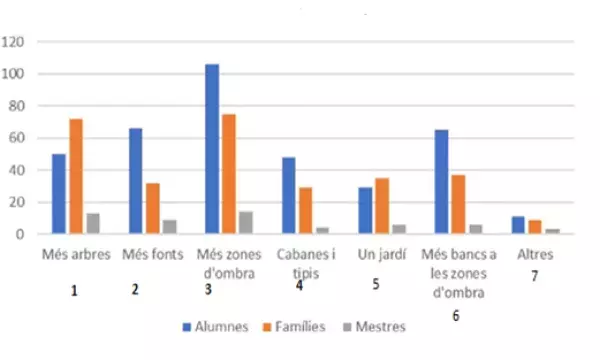
Furthermore, potential solutions for the conversion of the school to a Climate Shelter were examined through a wide and intensive participatory process, involving teachers, students and parents.
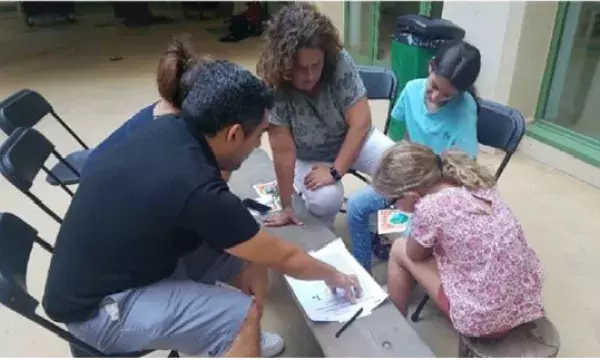
Source: Barcelona City Council – Urban Ecology Area
And the results are...
At last, a mixed group of teachers, parents and students assessed and ranked all suggested solutions, prioritizing those preferred. The group of architects in charge of the drafting of the construction projects selected those solutions considered as the most appropriate for the conversion of the Els Llorers school to a Climate Shelter (Image 7), according to the school’s needs, the studies performed under the scope of the project, the preferences of the school and the availability of funds.
Image 7. Solutions to be implemented at Els Llores School. 1: construction of new pergola; 2: modification of fountain; 3: reduction of existing sport yard; 4: creation of a garden 5: construction of a new pergola; 6: water games; 7: green reinforcement of fence; 8: fountain (Source: Barcelona City Council – Urban Ecology Area).
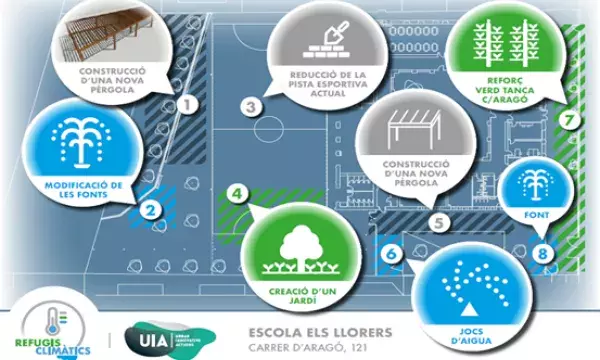
Open schooling in action
Barcelona’s Climate Shelters project reflects a solid demonstration of the implementation of the Open schooling concept. It leads to a participatory urban learning community (Figure 2), which particularly invites the urban youth, helps forming stewardship through the establishment of a sense of ownership and the ability to contribute to liveable neighborhoods and reduces societal disparities by building points of access for science discovery and participation.
"Open schooling" where schools, in cooperation with other stakeholders, become an agent of community well-being shall be promoted; families should be encouraged to become real partners in school life and activities; professionals from enterprises and civil and wider society should actively be involved in bringing real-life projects to the classroom. Relevant policy makers should also be involved, to encourage policy buy-in and the mainstreaming of good practices and insights into policies, and hence sustainability and impact beyond the lifetime of funding.(https://cordis.europa.eu/programme/id/H2020_SwafS-01-2018-2019)
Figure 2. The open schooling concept as applied in the Climate Shelters project (Source: C. Cartalis).

An approach to be replicated
Taking note of the similarity of challenges arising from societal, economic and climatic conditions in most cities in Europe and worldwide, the approach applied within the Climate Shelters project (both with respect to the integration of science to urban planning as well as to open schooling) may be successfully replicated.
Once done, it will provide a solid platform for the integration of science in urban policy planning and will promote innovation as far as adaptation to urban climate change is concerned. More importantly, it will contribute to the development of knowledgeable, innovative and participatory school communities able to cope with and actively contribute to addressing current and anticipated climatic challenges at the city scale.
Stay tuned to learn how the 11 schools and their schoolyards are being transformed into Climate Shelters.
About this resource
The Urban Innovative Actions (UIA) is a European Union initiative that provided funding to urban areas across Europe to test new and unproven solutions to urban challenges. The initiative had a total ERDF budget of €372 million for 2014-2020.
Similar content




